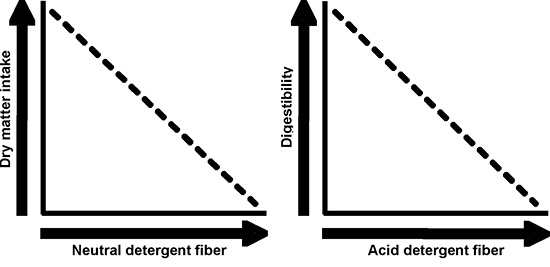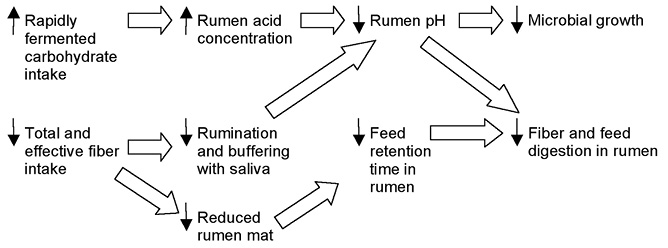Fiber in Beef Cattle Diets
While energy and protein are often the major focus of many beef cattle nutritional programs, fiber is another essential diet component beef cattle producers need to consider. Fiber type, quality, and length impact cattle health and productivity. Fiber is typically coarse and less dense than other feedstuff components, and the positive effects of feedstuffs on rumen health are related to their fiber content.
When Mississippi beef cattle operations experience hay shortages, producers must consider alternative fiber (roughage) sources for cattle nutrition programs. Effective fiber levels are typically not a concern in beef cattle on high-forage diets, such as when grazing with sufficient available forage or with free-choice hay supplementation. However, in periods of hay and grazing shortages, effective use of fiber substitutes in beef cattle diets becomes critical.
Ruminant livestock (cattle, goats, and sheep) can use large amounts of forage with high fiber content. Fiber can be defined as carbohydrates not digested by mammalian enzymes but digestible by rumen microorganisms. Fiber includes cellulose, hemicellulose, lignin, and soluble fiber (fructans, pectans, galactans, and beta-glucans). Most fiber in plant material is found in the structural components of cell walls.
In the rumen, fiber-digesting bacteria digest structural carbohydrates, while starch-digesting bacteria digest nonstructural carbohydrates. In general, the starch digesters tolerate low pH levels, but the fiber digesters are inhibited by low pH. If the goal is to maximize forage intake and digestibility, it may be counterproductive to add grain (corn, wheat, etc.) to the diet beyond a threshold of about 0.5 percent of body weight daily because of reduced rumen pH effects. A supplement with low levels of starch and highly digestible fiber (soybean hulls, corn gluten feed, dried distillers grains) is more appropriate to maintain forage intake, digestibility, and rumen pH. Rumen pH can also be kept from dropping too low by buffers secreted in the animal’s saliva. Salivary flow is primarily stimulated during rumination (cud chewing) by effective fiber.
Beef cattle diets lacking adequate fiber can damage the rumen wall. The effectiveness of fiber for supporting rumen health is positively related to particle size of the fiber and is often referred to as effective fiber. A high level of fiber in the diet does not always mean the fiber is effective. If the fiber is chopped or ground too short or fine, it may not promote rumen health. A minimum fiber length of ¼ inch can be adequate for chopping dry hay where the fiber source comprises a majority of the diet and the nutrition management level is high, but a fiber chop length of ½ inch is recommended for most production systems. Fiber chop length should be at least ½ inch when the effective fiber source makes up less than 25 percent of the diet.
Longer fiber helps form the rumen mat that is essential for proper rumen function and nutrient digestion. Just because a feedstuff contains high fiber levels does not mean it is in the form of effective fiber that promotes rumen health. A good example of this is soybean hull pellets. Soybean hulls are high in digestible fiber but have a small particle size and are relatively low in effective fiber levels. Effective fiber supplementation improves the performance of cattle fed soybean hull pellets. Therefore, do not use only soybean hull pellets as an exclusive fiber source to replace forages. Finely ground fiber passes through the digestive system rapidly and does not meet effective fiber needs of cattle.

NDF and ADF
Neutral detergent fiber (NDF) is commonly noted on forage test results. It refers to fiber that is insoluble in neutral detergent and includes cellulose, hemicellulose, and lignin. Neutral detergent fiber represents all plant cell wall material, is only partly digestible by animals, and is negatively correlated with dry matter intake. As NDF increases in the diet, dry matter intake decreases. Likewise, acid detergent fiber (ADF), the portion of fiber that is insoluble in acid detergent (cellulose and lignin), is negatively correlated with digestibility. Acid detergent fiber is composed of highly indigestible plant material, generally only the lignified or otherwise undigestible portions of plant cell walls. Generally, as ADF increases, forages or feeds become less digestible.

Forage quality standards in relation to NDF and ADF values appear in Table 1. Fiber values are often used in calculations to compute total digestible nutrients (TDN), a commonly used energy value for assessing forages and other feedstuffs for use in beef cattle diets. Table 2 lists estimated NDF and ADF values for selected forage crops grown in Mississippi. This table shows that legumes tend to have lower NDF and ADF values than grasses, and increasing forage maturity raises NDF and ADF values.
|
Forage quality standard |
Neutral detergent fiber, dry matter basis |
Acid detergent fiber, dry matter basis |
|---|---|---|
|
Prime |
less than 40% |
less than 31% |
|
1 |
40 to 46% |
31 to 35% |
|
2 |
47 to 53% |
36 to 40% |
|
3 |
54 to 60% |
41 to 42% |
|
4 |
61 to 65% |
43 to 45% |
|
5 |
greater than 65% |
greater than 45% |
Adapted from Ball et al. (2007).
|
Alfalfa |
Neutral detergent fiber, dry matter basis |
Acid detergent fiber, dry matter basis |
|---|---|---|
|
Bud stage |
38 to 47% |
28 to 32% |
|
Early flower stage |
42 to 50% |
32 to 36% |
|
Mid bloom stage |
46 to 55% |
36 to 40% |
|
Full bloom stage |
56 to 60% |
41 to 43% |
|
Annual ryegrass |
Neutral detergent fiber, dry matter basis |
Acid detergent fiber, dry matter basis |
|---|---|---|
|
Vegetative to boot stage |
47 to 53% |
27 to 33% |
|
Boot to head stage |
53 to 59% |
33 to 39% |
|
Bermudagrass |
Neutral detergent fiber, dry matter basis |
Acid detergent fiber, dry matter basis |
|---|---|---|
|
4 week old |
63 to 68% |
33 to 38% |
|
8 week old |
70 to 75% |
40 to 45% |
|
Corn silage |
Neutral detergent fiber, dry matter basis |
Acid detergent fiber, dry matter basis |
|---|---|---|
|
Well-eared |
48 to 58% |
23 to 30% |
|
Fair- to poor-eared |
58 to 67% |
30 to 39% |
|
Red clover |
Neutral detergent fiber, dry matter basis |
Acid detergent fiber, dry matter basis |
|---|---|---|
|
Early flower |
38 to 42% |
28 to 32% |
|
Late flower |
42 to 50% |
32 to 38% |
|
Tall fescue |
Neutral detergent fiber, dry matter basis |
Acid detergent fiber, dry matter basis |
|---|---|---|
|
Vegetative to boot stage |
50 to 56% |
30 to 36% |
|
Boot to head stage |
56 to 62% |
36 to 42% |
Adapted from Ball et al. (2007).
Effective Fiber
Effective fiber is expressed as effective NDF (eNDF). Effective NDF refers to the percentage of the NDF that effectively stimulates chewing and salivation, rumination, and rumen motility. Longer forage fiber lengths stimulate cud chewing (rumination) and saliva production. Saliva serves as a buffer in the rumen and helps stabilize rumen pH at levels beneficial to rumen function.
The importance of stimulating salivary flow to buffer rumen pH is well documented. Dietary levels of eNDF impact rumen pH and are often used to predict rumen pH for feeding formulations. Sufficient eNDF is important in beef cattle diets to keep rumen pH from dropping below acceptable levels to maintain feed intake. Diets high in grains (high-starch diets) often reduce rumen pH. However, highly digestible feeds high in pectins (soybean hulls, beet pulp, etc.) do not reduce pH as dramatically as many grains.
High-energy (e.g., finishing) diets require 8 percent eNDF, the concentration necessary to keep rumen pH above 5.7. Rumen pH below 5.7 dramatically reduces dry matter intake in cattle. If cattle gorge on high-starch feeds or there is a lack of effective fiber in the diet (leading to inadequate saliva secretion to buffer the rumen), rumen pH can remain low, and intake may drop off at the next feeding. Low pH levels for extended periods of time can shift the rumen microbial population in favor of bacteria that produce high levels of lactic acid, leading to acute acidosis. Cattle changing from high roughage to high concentrate diets need several weeks of gradual diet adjustment to allow shifts to rumen microbe populations that digest high starch levels without dropping rumen pH below 5.6.
Feedyards typically feed minimal amounts of roughage because finishing cattle are more efficient when fed high-grain diets. One of the major benefits of roughage in high-grain diets for finishing cattle may be as rumen fill that helps control grain intake and reduces incidence of liver abscesses. Increasing eNDF levels in finishing diets can reduce the level of management needed to maintain cattle digestive health. However, problems such as acidosis associated with feeding high-grain diets can be controlled with good bunk management.
|
Diet type |
Minimum eNDF required, % of dry matter |
|---|---|
|
High concentrate to maximize gain/feed, mixed diet, good bunk management, and ionophores |
5 to 8a |
|
Mixed diet, variable bunk management, or no ionophore |
20 |
|
High concentrate to maximize non-fiber carbohydrate use and microbial protein yield |
20b |
aTo keep rumen pH more than 5.6 to 5.7, the threshold below which cattle stop eating.
bTo keep rumen pH above 6.2, maximizing cell wall digestion and/or microbial protein yield.
Adapted from NRC (2000).
Bunk management can control wide variations in rumen pH and can reduce eNDF requirements to a minimum of 5 percent of dietary dry matter. Ionophores (monensin and lasalocid) added to the feed or mineral supplement can also reduce the quantity of feed that cattle consume at one meal and result in less rumen pH fluctuation. Under low rumen pH conditions (pH <6), little energy is derived from fiber, and microbial protein yield is reduced by at least one-third. Depending on feeding management, as much as 25 percent eNDF may be needed to maintain adequate pH for maximum forage digestion and microbial growth. Effective NDF levels that are too low can result in high passage rates and lower net energy values. Effective fiber levels can be increased by coarse-chopping instead of fine-chopping forages or by adding feeds with more effective fiber.
The eNDF in a feed or forage varies with the size of feed particles. Larger feed or forage particles are more effective at causing abrasive actions in the rumen, often referred to as “scratch factor.” The effective NDF level drops from 98 percent of NDF with long grasses to 73 percent of NDF with grasses less than ¼ inch long. In legumes, eNDF levels drop from 92 percent of NDF with long legumes to 67 percent of NDF with legumes less than ¼ inch in length. Therefore, feeding recommendations often specify a minimum forage staple length to ensure good rumen health. Reviewing the NDF and eNDF levels of common feedstuffs reveals why many “hay replacer” rations contain large percentages of cottonseed hulls. Cottonseed hulls are an excellent roughage and effective fiber source for beef cattle diets.
|
Feed |
NDF, % of dry matter |
eNDF, % of NDF1 |
|---|---|---|
|
Cottonseed hulls |
90.0 |
100 |
|
Whole cottonseed |
51.6 |
100 |
|
Bahiagrass hay |
72.0 |
98 |
|
Bermudagrass, late vegetative |
76.6 |
98 |
|
Tall fescue, mature |
70.0 |
98 |
|
Mature corn silage, normal chop |
41.0 |
71 |
|
Mature corn silage, fine chop |
41.0 |
61 |
|
Corn gluten feed |
36.2 |
36 |
|
Cottonseed meal |
28.0 |
36 |
|
Corn, dried grain |
9.0 |
60 |
|
Corn, cracked |
10.8 |
30 |
|
Soybean meal |
7.8 |
23 |
|
Hominy feed |
23.0 |
9 |
|
Distillers grains with solubles |
46.0 |
4 |
|
Soybean hulls |
66.3 |
2 |
|
Wheat middlings |
35.0 |
2 |
1Equals the proportion of NDF that is effective in stimulating rumination and is defined as the percent remaining on a 1.18 mm screen after dry sieving.
Adapted from NRC (2000).
Hay Replacer Diets
Hay replacer diets are formulated with high levels of fiber (roughage) to make up for forage shortfalls. The example hay replacer diets listed on the next page are intended for mature cattle. Growing cattle require different dietary nutrient levels from mature cattle. The ingredients listed in these hay replacers are not the only feedstuffs that can be used in these types of diets.
Many high-fiber feedstuffs are very bulky, so space requirements for storage along with feedstuff handling requirements should be factored into roughage source selection decisions. Cottonseed hulls are generally considered an excellent roughage source for cattle diets because of their excellent palatability and good intake results. Cotton gin trash and cotton gin mote are other examples of high-roughage feedstuffs available in Mississippi that can be used as effective fiber sources and hay replacers. Cotton gin mote typically contains fewer intact cotton stalks than cotton gin trash and provides less long staple fiber than either cottonseed hulls or cotton gin trash.
|
Ingredient |
Diet 1 |
Diet 2 |
Diet 3 |
Diet 4 |
Diet 5 |
|---|---|---|---|---|---|
|
Corn |
730 |
325 |
|||
|
Cottonseed hulls |
889 |
952 |
548 |
1300 |
700 |
|
Cottonseed meal |
295 |
152 |
150 |
100 |
|
|
Soybean hulls |
1283 |
||||
|
Corn gluten feed |
1089 |
||||
|
Oats |
1180 |
||||
|
Cane molasses |
175 |
||||
|
Limestone |
13 |
14 |
6 |
||
|
Dicalcium phosphate |
2 |
10 |
|||
|
Urea |
20 |
||||
|
Trace mineral salt1 |
9 |
9 |
9 |
20 |
20 |
1A Vitamin ADE premix should be included in the diet. See Mississippi State University Extension Service Publication 2484 Mineral and Vitamin Nutrition for Beef Cattle for mineral and vitamin supplementation recommendations.
Corn stalks (also referred to as corn stubble or corn stover) are a roughage option some beef cattle producers use, particularly when corn crop residues are widely available and other roughage sources are expensive or in short supply. Be sure to monitor nitrate levels when including corn stalks in the nutritional program. Corn stalks are a low-quality feedstuff and should be supplemented in almost all feeding situations. Corn gluten feed and limestone or corn and soybean meal are examples of feed ingredient combinations that can be supplemented with corn stalks successfully. Use the nutrient analysis results from forage testing corn stalks to determine the specific feedstuff levels needed to balance the diet.
Exercise extreme caution when including rice hulls or peanut hulls as roughage sources in beef cattle diets. These feedstuffs have relatively little nutritional value for beef cattle and can cause digestive tract disruptions when fed at moderate to high levels. Never feed crushed or ground peanut hulls to cattle.
Planning ahead to acquire adequate roughage supplies can provide cattle producers with more nutrition program options when feed or forage supplies become limited or more expensive. Producers should consider effective fiber needs when deciding on appropriate fiber substitutes for hay replacement programs. For more information on fiber in beef cattle diets, contact your local MSU Extension office.
References
Ball, D. M., C. S. Hoveland, & G. D. Lacefield. 2007. Southern Forages. 4th ed. Potash and Phosphate Institute and Foundation for Agronomic Research. Norcross, GA.
National Research Council. 2000. Nutrient Requirements of Beef Cattle. 7th Revised Edition, 1996: Update 2000. National Academy Press. Washington, DC.
Trenkle, A. 2002. Formulating beef cattle rations for fiber and starch to optimize animal health and productivitiy. Intermountain Nutrition Conference Proceedings. Utah State University. Logan, UT.
Publication 2489 (POD-03-22)
Reviewed by Brandi Karisch, PhD, Associate Extension/Research Professor, Animal and Dairy Sciences. Written by Jane A. Parish, PhD, Professor and Head, North Mississippi Research and Extension Center; and Justin D. Rhinehart, PhD, former Assistant Extension Professor, Animal and Dairy Sciences.
The Mississippi State University Extension Service is working to ensure all web content is accessible to all users. If you need assistance accessing any of our content, please email the webteam or call 662-325-2262.





